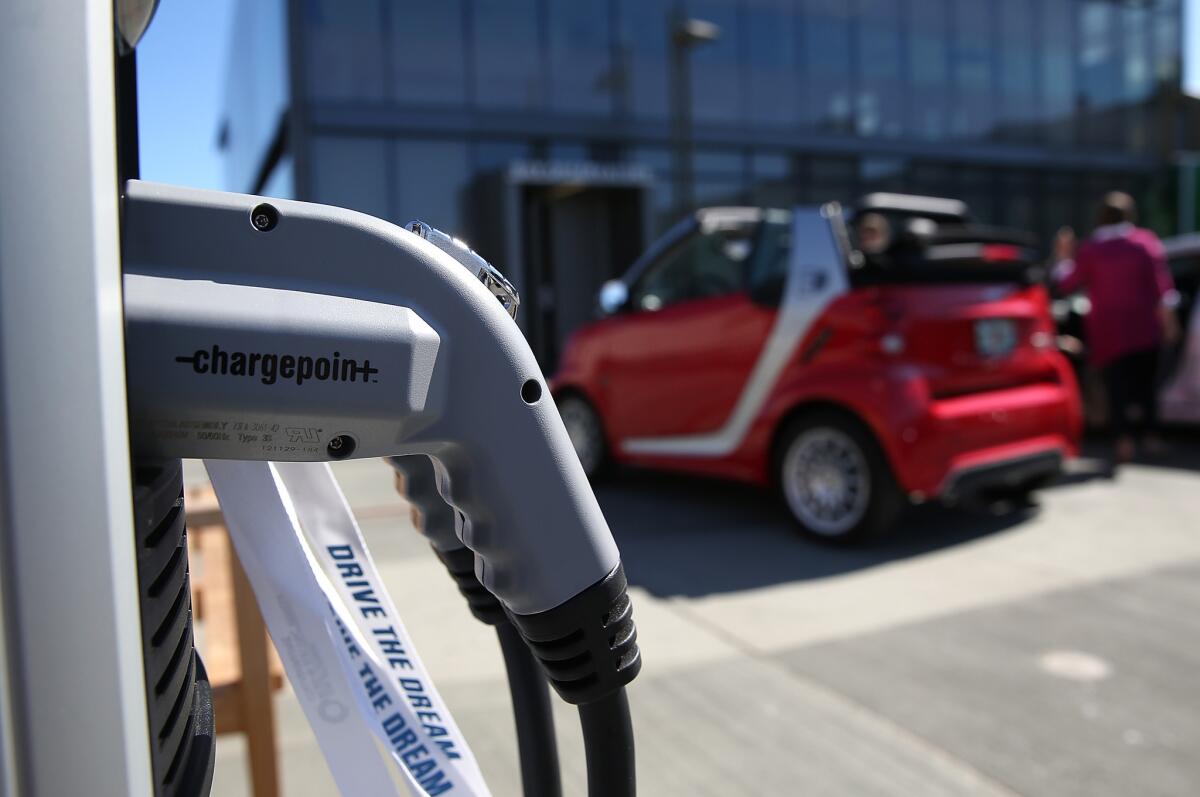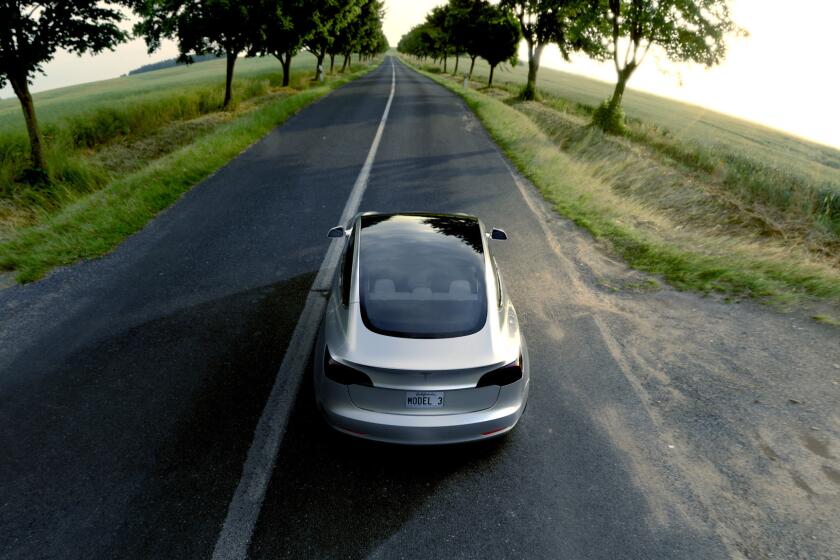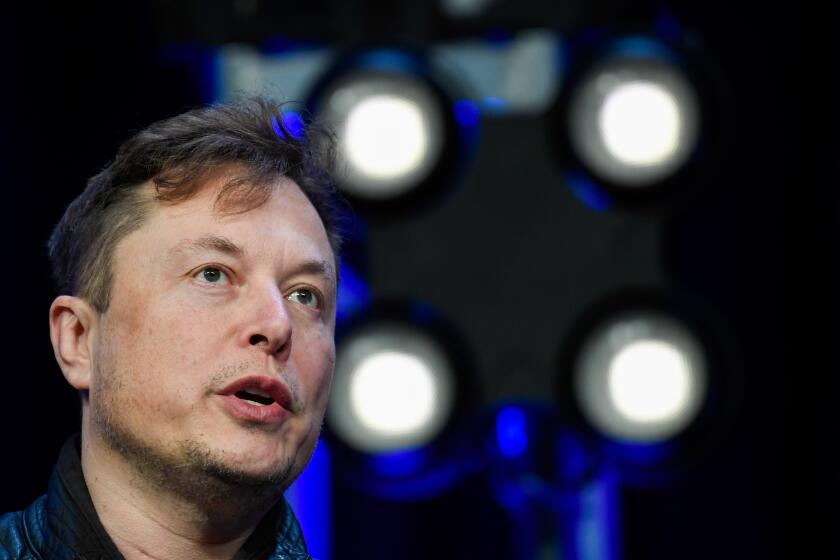California pulls back clean-vehicle rebates to point them at lower-income buyers

- Share via
Starting in December, those looking to buy electric vehicles with a price tag of more than $60,000 won’t qualify for California’s clean-vehicle rebate. The rebate is also disappearing for plug-in hybrids with less than 35 miles of all-electric range.
The California Air Resources Board approved these changes, effective Dec. 3, as part of a move to distribute the state’s resources toward lower-income communities, and away from wealthy buyers.
Standard rebates for fully electric vehicles that qualify will be reduced from $2,500 to $2,000, while the rebate for plug-in hybrids will drop from $1,500 to $1,000. Rebates for fuel-cell vehicles will fall from $5,000 to $4,500. Rebates for low- to moderate-income buyers will stay at $4,500 for EVs, $3,500 for plug-in hybrids and $7,000 for fuel-cell vehicles.
Whereas previously consumers could qualify for two rebates, starting in December they will be limited to one in a lifetime.
The Clean Vehicle Rebate Project, part of the state’s low-carbon transportation program, has seen a steady climb in applicants for clean-vehicle rebates since it launched in March 2010. To date, 346,423 rebates have been issued or approved for all-battery electric or plug-in hybrid highway vehicles, according to the Center for Sustainable Energy, with a funding of more than $773.5 million.
Demand exceeds the current budget, and the program has become oversubscribed in recent years, said Melanie Turner, spokeswoman for the project.
EV sales rose 65% in California in the first half of the year, led by Tesla. But that doesn’t mean consumers are suddenly in love with electric cars.
The California Air Resources Board increased incentive levels for low- and moderate-income consumers by $1,500 and implemented high-income eligibility caps in 2016, under the direction of Senate Bill 1275. The state Legislature has continued to extend and expand that policy. The Air Resources Board last month approved a $533-million funding plan for fiscal year 2019-20 that includes $238 million for the rebate program, with a stipulation that $25 million of that be used to fund increased rebates for low-income consumers.
“They’re trying to make the money go further and also direct it to those in disadvantaged communities who would benefit the most,” Turner said.
But the high cost of vehicle batteries makes it difficult to make money on electric cars and trucks, which explains why most new EVs are aimed at more affluent buyers. Only seven of the approximately 45 new electrics that are planned for introduction between now and 2023 will cost under $40,000 before options are added on, according to EVAdoption. More than 30 of the new models will be priced above $60,000, and a few will top $200,000.
Changes in incentives probably won’t influence sales of high-priced vehicles being introduced by brands such as Porsche. The Porsche Taycan electric sports sedan, soon to hit showrooms, starts at $150,000. Porsche spokesman Calvin Kim said buyers of six-figure vehicles are drawn more by a luxury brand than clean-car incentives.
But pricing could get tricky for cars that come in near $60,000 before options. The upcoming Volvo XC40 all-electric compact SUV is expected to sell in the mid-$50,000 range.
Assemblyman Phil Ting (D-San Francisco), who has been a vocal advocate of electric-car rebates in the Legislature, said reducing the rebate from $2,500 may “dampen the excitement for clean cars,” especially since Tesla and General Motors are losing their federal tax credits.
Customers get a $7,500 federal tax credit for new all-electric vehicles, but that credit winds down gradually to zero as car manufacturers sell more vehicles, and it disappears completely once sales volume hits 200,000 vehicles. The credit for a new Tesla has dwindled to $1,875 and will disappear in January. General Motors, which sells the Chevy Bolt, will see its $1,875 rebate reduced to zero on March 31.
Ting believes that rebates should be increased overall, not decreased. He said that people with lower incomes tend to buy used cars, and that the state should bolster used-car programs such as Clean Cars 4 All and Clean Vehicle Assistance Program instead of cutting rebates in the Clean Vehicle Rebate Project, which is primarily for new cars.
Ting said he would put further restrictions on plug-in hybrids in order to free up resources for bigger rebates on electric vehicles.
“Why are we rebating technology that’s in the past at the expense of encouraging completely clean vehicles?” Ting said.
Waymo wants to deploy a robotaxi service for the general public in parts of California as soon as possible.
Dan Edmunds, director of vehicle evaluations at automobile information site Edmunds, agreed that increased restrictions on low-range plug-in hybrids was overdue. He said the market is full of plug-in hybrids that run in the 20-mile range when in electric mode, which he doesn’t think makes them viable vehicles.
“The idea should be to have enough range that they can be an electric car for your commute to work and a gasoline engine for your longer trips on the weekend, but they aren’t configured with the range to do that,” Edmunds said. “I’m not sorry to see those go, frankly.”
Edmunds said more affordable electric vehicles are hitting the market. Hyundai sells the all-electric Ioniq for about $32,000 before incentives, and a $30,000 electric Mini Cooper is coming soon. That should give buyers more options, he said. He thinks rebates will encourage those who have never owned an electric car to make the switch.
“I think focusing our efforts on first-time buyers at a more entry-level price point isn’t a bad thing,” Edmunds said.
Times staff writer Russ Mitchell contributed to this report.








